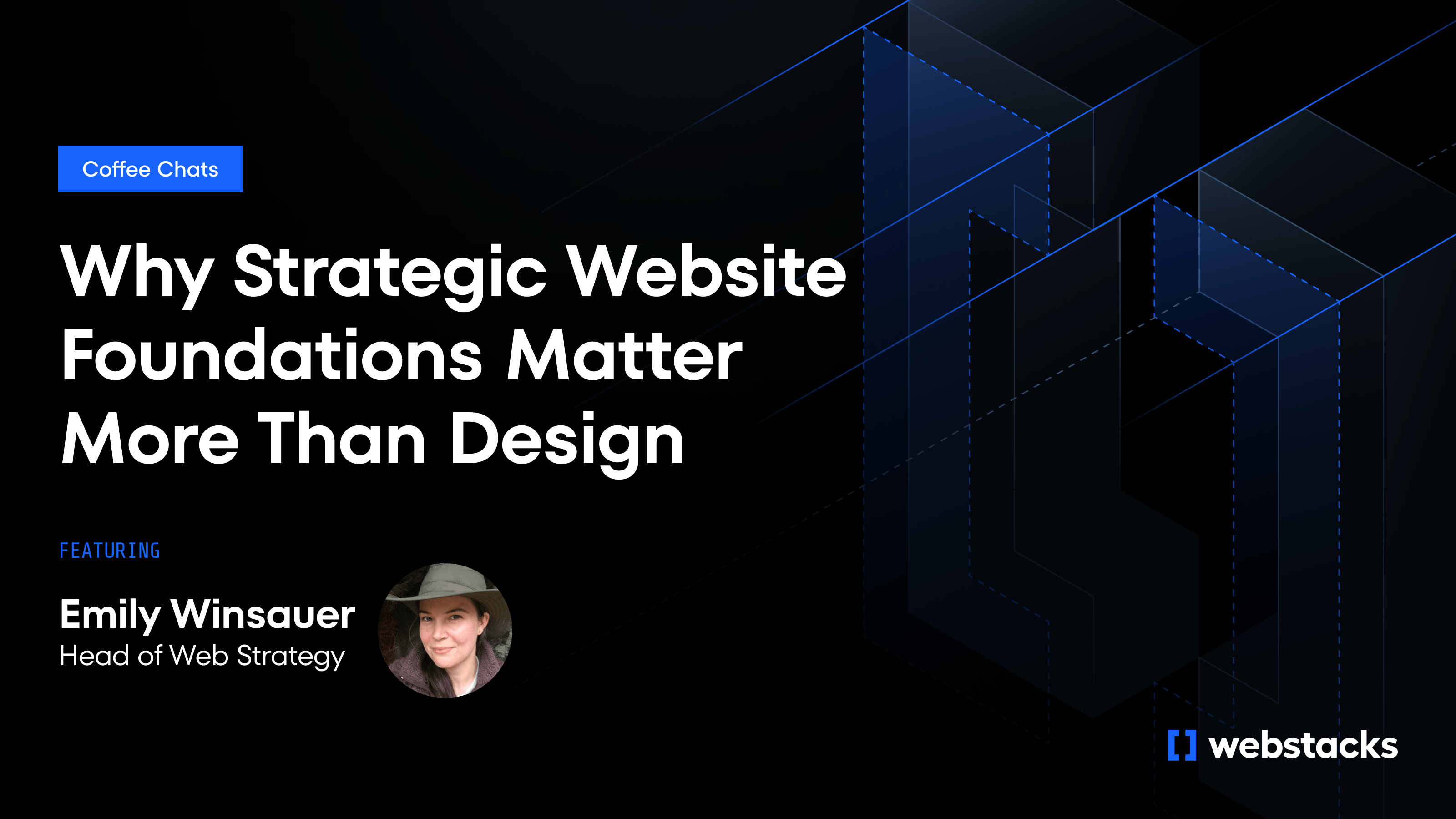Marketing and digital leaders at healthcare and MedTech companies are under constant pressure to generate high-quality leads and deliver measurable ROI.
But legacy systems, fragmented digital experiences, and slow development cycles often stand in the way of healthcare lead generation.
The challenges are familiar: outdated websites that don't reflect current offerings, rigid CMS platforms that slow down campaign launches, and the need to speak to multiple audiences on a single platform.
Add to that the need for compliance and performance, and it's clear that lead generation in healthcare requires you to rethink your entire digital foundation.
At Webstacks, we’ve helped many MedTech and healthcare marketing teams build websites that evolve with their business and capture the right users. And this has given us a lot of insights into what kind of lead generation strategies work.
In this article, we'll share 10 strategies modern healthcare brands use to generate leads.

1. Develop a Modular and Scalable Website Infrastructure
Healthcare lead generation is only as effective as the system supporting it. When marketing teams rely on static templates or hard-coded pages, even simple campaign updates can take weeks.
A modular website design and scalable website infrastructure solve this by shifting control back to marketers. They can tweak pages and publish content independently.
Consider a growth-stage MedTech company that needs to launch a regional campaign for its diagnostic platform.
With a traditional site, this would require engineering support, custom layouts, and QA checks. However, with a modular design system, the marketing team can assemble localized landing pages using reusable components.
For example, when Curative transitioned from COVID-19 testing to employer-sponsored health insurance, they needed a site that could support entirely new audiences.
Webstacks implemented a modular design system and structured CMS, giving their team the flexibility to launch new pages, support segmented user journeys, and scale content without engineering bottlenecks.
2. Implement a Headless CMS
Traditional CMS platforms often become a bottleneck. Pages are tightly coupled to templates, publishing workflows are clunky, and even minor updates can require development resources. For healthcare teams managing multiple service lines, locations, or compliance-sensitive content, this slows down lead generation at every level.
A headless CMS decouples content from presentation, allowing marketers to publish across channels, create localized experiences, and manage updates at scale.
In a headless setup, you also build a foundation for future growth. As digital channels expand, from web to mobile to patient portals, you won't need to rebuild content from scratch.
3. Optimize for Search Engines with Healthcare-Specific SEO Strategies
Lead generation starts with discoverability. If patients, providers, or partners can't find your website through a search, you're missing out on high-intent traffic.
Healthcare SEO requires a more nuanced approach. You often target multiple personas, navigate sensitive language, and compete with providers and publishers in search results. The correct strategy balances performance with purpose.
Imagine a MedTech company that launched a new remote monitoring device for post-operative care. To build awareness and generate leads, it needs to rank for product-focused terms like "post-surgical vitals monitoring" and informational queries like "how to track vitals after surgery."
A strong SEO strategy helps it capture high-intent commercial searches and earlier-stage educational traffic, pulling leads into the funnel before they know they're ready to convert.
Webstacks builds healthcare websites with SEO baked in from day one. That means technical SEO (site speed, structure, accessibility), content architecture (topic clusters, internal linking), and performance monitoring.

4. Use Thought Leadership to Build Trust
From hospital systems to private practices, decision-makers want to work with brands that understand their challenges and offer credible solutions. Thought leadership is how you show them you're that brand.
By publishing expert content—whitepapers, opinion pieces, interviews, or webinars—you position your company as a strategic partner, not just a vendor.
Thought leadership also improves content performance across channels, fueling SEO, boosting engagement in email, and increasing conversion rates on lead-gen landing pages.
5. Use Data-Driven Personalization
Not all healthcare buyers are the same. A patient looking for urgent care, a provider evaluating a new diagnostic tool, and a payer researching cost-effectiveness bring different needs and expectations to your site. Generic content won't convert them, but personalization will.
Data-driven personalization uses behavioral and demographic signals to tailor the experience in real-time. This could mean dynamic headlines based on referral sources, localized content by IP address, or custom CTAs for returning visitors. The result: higher relevance, stronger engagement, and better lead conversion.
6. Integrate Multi-Audience UX Design
Most healthcare websites aren't just serving one audience. A multi-audience UX strategy ensures each user can quickly identify that they're in the right place and take the next step.
Navigation matters, but so does content organization, pathway structure, and how users find the information they care about.
This way, you will:
- Reduce confusion and bounce rates for first-time visitors
- Increase content relevance and lead form completion
- Improve clarity across complex buyer journeys
7. Implement Compliance-Ready Features
You need to meet HIPAA, GDPR, and ADA standards, whether you're collecting leads, integrating third-party tools, or publishing patient-facing content.
Building compliance into your design and development process protects user data, reduces legal risk, and keeps the experience fast and user-friendly.
For example, if a virtual care platform wanted to collect online intake forms to pre-qualify patients, they could work with developers to build a HIPAA-compliant form experience with secure data transmission and user consent flows.
Beyond forms, compliance also applies to how you use analytics, cookies, accessibility tools, and CRM integrations.
8. Use Marketing Automation Tools
Manual lead nurturing doesn't scale, especially in healthcare, where education cycles are long, stakeholders are varied, and buying decisions are complex. Marketing automation bridges the gap by creating consistent, targeted follow-up at every funnel stage.
With the right tools, you can engage leads with personalized email sequences, trigger content based on behavior, and score prospects based on readiness.
Automation also helps align marketing and sales teams by providing better visibility into lead behavior and intent, enabling more informed outreach when the time is right.
9. Conduct A/B Testing for Continuous Improvement
Even high-performing healthcare websites can underdeliver if teams aren't actively testing and refining how users engage with key content. What resonates with one audience or persona might fall flat with another. A/B testing provides the data to validate decisions and continuously improve lead generation performance.
From testing CTA language to trying different hero images or layouts, experimentation helps uncover what motivates users to take action and what causes friction. Instead of relying on assumptions, teams can use testing to guide more effective design and content choices.
At Webstacks, we build websites with testing in mind from the start. Our modular design approach allows for easy iteration, and we help clients integrate A/B testing tools to experiment with real user behavior.
10. Monitor and Analyze Key Performance Indicators (KPIs)
Lead generation doesn't end with a form fill. It's a continuous process that requires tracking users' engagement with your site and identifying where to optimize next. Without clear visibility into performance, teams can't confidently scale what's working or fix what's not.
The right KPIs give marketers a full view of the funnel: traffic sources, conversion paths, content engagement, bounce rates, and lead quality.
KPIs aren't just for post-launch reporting. They should initially guide your content strategy, page design, and site structure. Over time, performance data becomes a competitive advantage.
Turn Your Website Into a Growth Engine
Lead generation in healthcare is about building a digital system that educates, engages, and converts across every touchpoint. That means giving your marketing team the tools and infrastructure to move confidently.
At Webstacks, we partner with healthcare and MedTech companies to build websites that do just that. If your current site is slowing down lead generation, it may be time for a new foundation.
Let’s build a platform that helps your team move faster and generate better leads.




